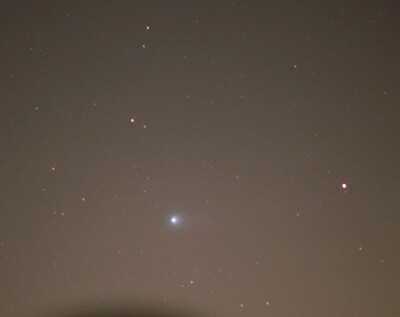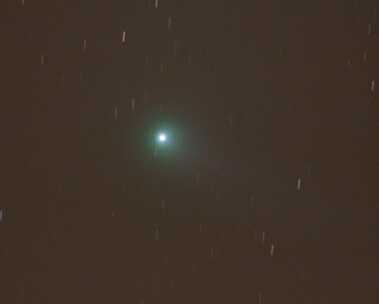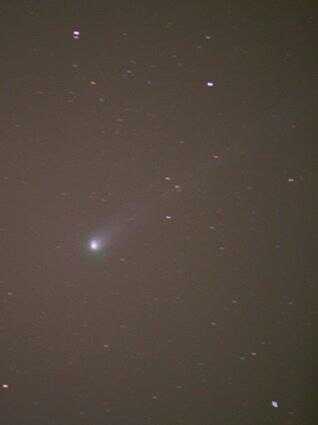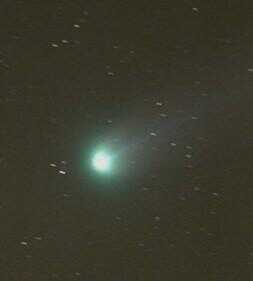|
9.March 1996 Universal time : 02.40 Telescope/Camera : 200mm f/4.5 Exposure time and film: 0.5 min. on Konica Color XG 100 It is still faint and far from the earth. The faint spot in the middle just over the neighbour's house. Digitized by Kodak. |

|

|
10.March 1996 Universal time : 02.51 Telescope/Camera : 200mm f/4.5 Exposure time and film: 0.5 min. on Konica Color XG 100 The almost full moon dominate. The comet is barely visible. Digitized by Kodak. |
|
11.March 1996 Universal time : 02.06 Telescope/Camera : 200 mm f/4.5 Exposure time and film: 5 min. on Konica Color XG-100 The neighbour's chimney touch Hyakutake. Digitized by Kodak. |

|
|
12.March 1996 Universal time : 02.25 Telescope/Camera : 200 mm f/4.5 Exposure time and film: 10 min. on Konica Color XG-100 Digitized by Kodak. |

|
|
20.March 1996 Universal time : 02.48 Telescope/Camera : 0.10m f/6 Exposure time and film: 3 min. on Konica Color XG 100 Digitized by Kodak. |

|

|
22.March 1996 Universal time : 01.05 Telescope/Camera : 0.10m f/6 Exposure time and film: 4 min. on Konica Color XG 100 It is closing fast toward the earth. Digitized by Kodak. |
|
22.March 1996 Universal time : 22.30 Telescope/Camera : 55 mm f/1.8 Exposure time and film: 5 min. on Konica SuperXG-100 Wide angle view of the sky. Digitized by Kodak. |

|
|
22.March 1996 Universal time : 23.31 Telescope/Camera : 200 mm f/4.5 Exposure time and film: 15 min. on Konica Super XG-100 Digitized by Kodak. |

|

|
23.March 1996 Universal time : 22.50 Telescope/Camera : 0.10m f/6 Exposure time and film: 3.5 min. on Konica Super XG-100 Digitized by Kodak. |

|
25.March 1996 Universal time : 00.55 Telescope/Camera : 200 mm f/4.5 Exposure time and film: 13 min. on Konica Super XG-100 Now I easily can see the comet move in real time. It is at perigeum. Digitized by Kodak. |

|
25.March 1996 Universal time : 01.45 Telescope/Camera : 55 mm f/1.8 Exposure time and film: 16 min. on Konica Super XG-100 Digitized by Kodak. |

|
26.March 1996 Universal time : 00.06 Telescope/Camera : 55 mm f/1.8 Exposure time and film: 15 min. on Konica Super XG-100 Digitized by Kodak. |

|
26.March 1996 Universal time : 00.31 Telescope/Camera : 200 mm f/4.5 Exposure time and film: 5 min. on Konica Super XG-100 Digitized by Kodak. |
|
26.March 1996 Universal time : 02.40 Telescope/Camera : 200 mm f/4.5 Exposure time and film: 5 min. on Kodak Gold 100 Digitized by Kodak. |

|
|
26.March 1996 Universal time : 21.58 Telescope/Camera : 200mm f/4.5 Exposure time and film: 11 min. on Kodak Gold 100 Digitized by Kodak. |

|

|
27.March 1996 Universal time : 00.30 Telescope/Camera : 55 mm f/1.8 Exposure time and film: 12 min. on Kodak Gold 100 Digitized by Kodak. |
|
28.March 1996 Universal time : 20.28 Telescope/Camera : 400mm f/9 Exposure time and film: 21 min. on Kodak Gold 100 Digitized by Kodak. |

|
|
30.March 1996 Universal time : 20.00 Telescope/Camera : 400 mm f/9 Exposure time and film: 17 min. on Kodak Gold 100 Digitized by Kodak. |

|

|
8.April 1996 Universal time : 20.26 Telescope/Camera : 0.10m f/6 Exposure time and film: 4 min. on Kodak Gold 100 The Comet's appearance now changed very little until it became too close to the sun for observations. Digitized by Kodak. |